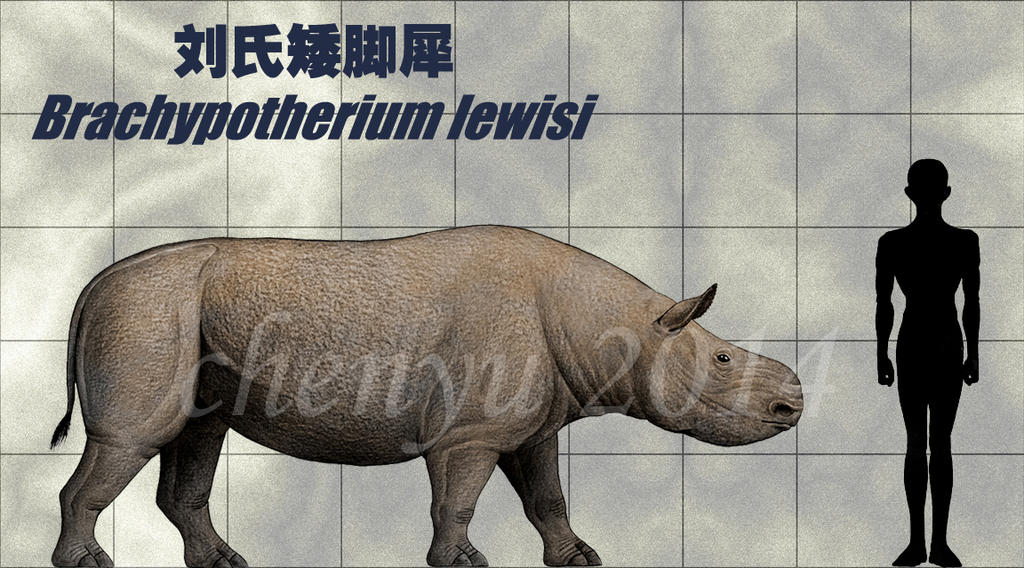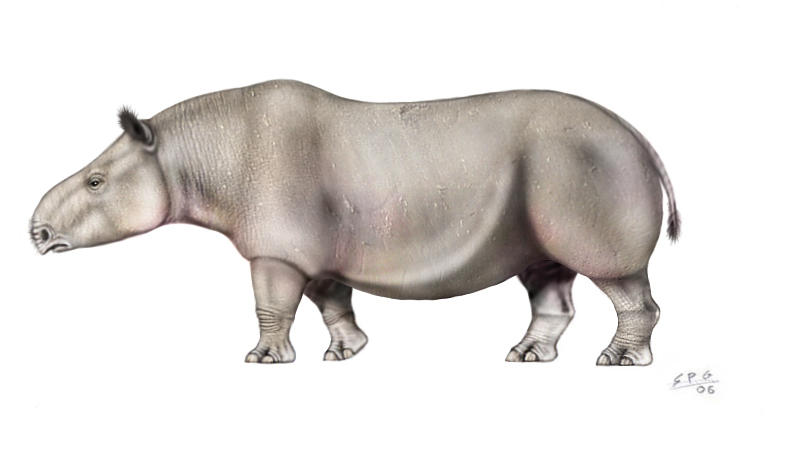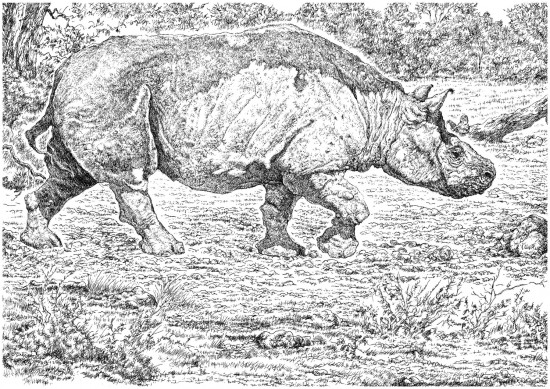Brachypotherium
Lower jaw of Brachypotherium
- Asia
- Europe
- Africa
Brachypotherium is a genus of extinct rhinos, whose representatives were common in the Middle and Upper Miocene million before 17-4 years over large parts of Europe, Asia and Africa. The animals were characteristic short legs and had no horn formation. With an estimated live weight of 5 t they were among the largest known rhinos. They lived in open woodlands, feeding on soft plant foods.
Features
The representatives of Brachypotherium were large to very large rhino with a plump physique, a short skull and relatively short limbs, which end in three toes. With an estimated body weight of partly more than 5 tons, they were the largest rhino representatives of their time and in addition to the species of the genus Elasmotherium the largest known forms of the rhinoceros phylogeny of this group of mammals.
The skull of Brachypotherium species was relatively short and had a wedge-shaped outline. Furthermore, he pointed in the right side view of a flat shape. The length was up to 71 cm. The occiput showed a fairly short and rectangular shape and was partly rounded at the rear. Also, the nasal bone was relatively short, reaching up to 12 cm in length. It had no roughening of the surface that one can assume that the Brachypotherium species probably had no horn. Furthermore, the nasal bone was not connected to the premaxillary bones, but ended about 15 cm in front of its front edge. Striking were also quite far forward orbits, which were located above the second molar.
The mandible was at least 45 cm long and was very solid with up to 9 cm high bone body and wide joint ends. The dentition was significantly reduced, especially in the front area. The dental formula of adult animals is:. A distinctive form had the conical and with up to 11 cm very elongated lower incisors, which were slightly curved, so that the tips reported upwards and thus resembled small tusks. However, the roots of the incisors were relatively short. The upper incisors were completely flat shaped. The posterior dentition showed rather low tooth crowns ( brachyodont ), but partly also reached a moderate amount of teeth. These were built quite primitive, but had individual anatomical features. In addition, the premolars resembled the molar teeth were so molarisiert significantly. The premolars and molars was recorded above very broad chewing surfaces. At most there were the last two molars, which were up about 6 inches long.
Most characteristic feature of the body skeleton were the shortened limbs. Thus, the humerus was strong and solid was approximately 49 cm long, the radius up to 36 cm. The femur reached 47 cm in length, tibia, however, up to 35 cm. Both the front and the rear limbs ended - as in today's modern rhinos - each with three toes, the central beam ( Metapodium III) was the most educated and the hand 18 cm ( metacarpus ), at the foot 16 cm ( metatarsus ) was long. Unlike other three-toed rhino the second beam ( Metapodium II) was hardly reduced.
Locations
Fossil remains of Brachypotherium are known mainly from Central, Western and Southern Europe, West and Central Asia and Africa, where they generally reached a fairly wide distribution. In Germany finds come mainly in the southern parts of the country. So they have been discovered in the Dinotheriensanden at Eppelsheim, but also in the Upper Freshwater fossils came to light, as in Steinheim. There are but usually only before single finds. From Austria fossils have been described from Atzelsdorf northeast of Vienna. Numerous postcraniales skeletal material came in Dúbravská poles in Slovakia days. Outstanding are the remains of Simorre in France, which include in addition to skeletal remains also extensive remains of the body skeleton. Also common are finds of tooth and bone remains from Spain, but also from South Eastern Europe.
From Asia come numerous and outstanding finds from Anatolia, as of the Hominoidenfundstellen Pasalar and Çandır, and from the SINAP lineup and include both skull fragments and postcranial skeletal elements. All these findings are largely a thing of the Middle Miocene. Many, but often fragmented fossils are known from the Siwaliks in Pakistan, where they are assigned to the Kamlial and Chinji lineup. Further noteworthy are jaw fragments from late mid-to Upper Miocene deposits of the Irrawaddy in Burma. Significantly isolated finds are from Japan, where several teeth, but also a lower jaw from various Central and Upper Miocene rock deposits in the eastern part of the island of Honshu were found. Besides fossils from North Africa of the most important findings of this continent each include a nearly complete skull from Lothagam un Buluk, both in Kenya, while a lower jaw fragment from Namibia is one of the southernmost finds this rhino species.
Paleobiology
The partly niederkronigen molars have Brachypotherium than a genus of herbivores with specialization in soft plant food like leaves, twigs or buds. However, the typical scratch pattern on the teeth can also be a certain amount of hard grass diet suspect. The habitat of these rhinos may have been forests with a certain amount of open land. The construction of the limbs, but especially of the hand and foot bones, continues to speak for travel in more open terrain, marshy areas were therefore seldom visited. A frequently postulated semi- aquatic lifestyle, such as accept his hippo -like habit could, has not been established. The frequent association of Brachypotherium with the tusker representatives of the genus Deinotherium who preferred a similar landscape, occupied these views.
System
Brachypotherium is a genus of the subfamily Aceratheriinae, a group of rhinoceros often hornless animals. Within which it belongs to the tribe of Teleoceratini, whose members are characterized by short legs. However Brachypotherium thus represents a more conservative branch of the tribe, as the genus, despite the spread of open areas underwent no significant specialization on hard plant foods and so its mostly niederkronigen molars largely retained. The cuts of the limbs was significantly lower than that of the closely related and simultaneous, but living in North America Teleoceras.
Several species have been described from Brachypotherium, the following of which are still valid today:
- B. brachypus Lartet, 1937
- B. fatehjangense Pilgrim, 1910
- B. goldfussi Kaup, 1834
- B. heinzelini Hooijer, 1963
- B. lewisi Hooijer, 1972
- B. minor Geraads & Miller, 2013
- B. perimense Falconer & Cautley, 1847
- B. Pugnator Matsumoto, 1921
- B. shanwangensis, Wang, 1965
- B. snowi Fourtau, 1918
Species such as aurelianense Originally described from the Miocene also placed today largely Prosantorhinus others to Diaceratherium. Americanum The once viewed as an American representative example of the genus Teleoceras has now been assigned.
The first description of Brachypotherium was in 1904 by Roger O., which he made on the basis of findings from the Dinotheriensanden. However, Roger had already used the name in an unpublished manuscript. The partially quite early Brachypotherium described species were often initially assigned to other genera such as rhinoceros Rhinoceros, Teleoceras or Aceratherium. The name Brachypotherium derives from the Greek words βραχύς ( brachys " short"), πούς ( pous "foot" ) and θηρίον ( Therion "animal" ) and refers to the short -trained limbs of animals.
Phylogeny
The first occurrence of Brachypotherium was at the beginning of the Middle Miocene. Perhaps the genre emerged from the Miocene from the previous form Prosantorhinus. Early findings are from the Siwaliks in Central Asia and Western Europe. The most widespread they reached Upper Miocene, where representatives of the genus in Asia, Europe and Africa occurred. The last occurrence of this rhino species in Europe is guaranteed before around 8 million years ago, where it is still known from localities in Bulgaria. The recent finds were discovered in eastern Africa and are dated to the early Pliocene around 4.2 million years ago.










